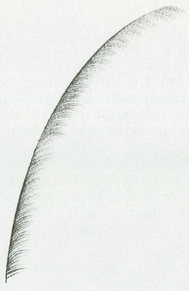PAINTING GRASSES

Figure 44 Flowering grass stem in colour, showing (inset) how the flower head is built up
The Mustard Seed Garden Manual of Painting 6 has a section entitled ‘Book of Grasses and Insects’, but closer examination reveals that it is concerned mainly with flowers such as orchid, chrysanthemum and peony. Only four pages are devoted to grasses as we understand them and even these are concerned with grasses simply as ground cover in landscapes and flower paintings. Grass is seldom the main feature of a Chinese painting but it is used so often to enhance pictures of flowers, birds and insects that I think it is useful to accord it a section on its own here.
The normal distinction between outline and freestyle methods does not have much relevance to painting grass since it is very seldom outlined. The chief difference between the grass in a gongbi painting and that in a xieyi one is that the former is more painstakingly and tidily executed. If you want to try outlining grass, draw it with a fine-pointed brush.
Flowering grass stem
Figure 44 shows a flowering grass stem in colour. To paint this, do the stalk first, using a yellowish green. Imagine you are painting a thin, bendy bamboo stem and you will achieve the correct effect (bamboo is after all a grass). Likewise, the leaves are done in much the same way as bamboo leaves, although they should be slightly longer and some of them should be turned by varying the brush pressure in the same way as for orchid leaves (see page 46). Use a slightly bluer green for these. For the flower head, first draw in the stems with the point of your brush. Make the seeds by pressing slightly with the tip of the brush, starting with grey seeds and adding purple or yellow ones. As a final touch you can add some white seeds, remembering that the more white you add the riper your grass will look.
Other grasses
The grass in figure 45 is done with a ‘feather’ or ‘split brush’ stroke. Do not have your brush too dry or you will not achieve an even stroke. ‘Split’ brush docs not necessarily imply ‘dry’ brush. First do the stem rather like a thin orchid leaf (see page 46), using only the tip of your brush. Then splay out the bristles and add the feathery fronds by working outwards from the stem.
Figure 46 shows a few examples of the grass and undergrowth often used in the foreground of landscapes.

Figure 45 ‘Feathered’ grass stem

Figure 46 Grass and undergrowth of the kind frequently used in the foreground of landscapes

Figure 47 Xieyi-style grasses
Xieyi-style grasses
Figure 47 illustrates some freestyle grasses of the type which frequently occur in xieyi paintings of birds and animals. Ideally they should be done with a horse-hair brush (see page 22) but it is possible to do them with a dry wolf-hair brush with its tip twisted so that the end splays out slightly to give a split effect. Instead of pulling the brush to form the stem as you did for figure 44, reverse the stroke and push the brush to make the stem segments. The leaves are done in the same way as before but the effect of the horse-hair brush is to make them look unkempt. The grass heads are also done with the horse-hair brush. Naturally these xieyi grasses can also be done in colour.